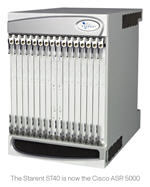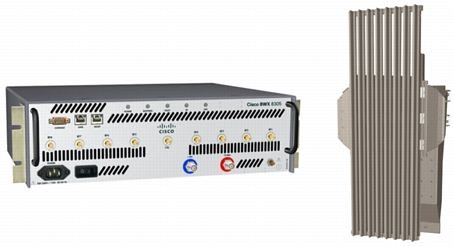 Cisco Systems will no longer make WiMax base stations, reported Fierce Wireless last week. Cisco bought Navini Networks for $330 million in 2007.
Cisco Systems will no longer make WiMax base stations, reported Fierce Wireless last week. Cisco bought Navini Networks for $330 million in 2007.
A Cisco’s spokesman emailed Light Reading Mobile the following statement:
After careful review of our mobility strategy and investments, we have decided to discontinue designing and building new WiMAX base stations. As part of this decision, we are committed to continue with our current service provider mobility strategy to provide a radio-agnostic approach to focus on the packet core and to also focus investment in radio technologies such as Femtocell and Wi-Fi. We believe the best way for Cisco to serve our customers is by delivering value at the edge and core of our customers’ networks.
The Cisco BWX 8300 Series used an 8-element antenna array and advanced RF techniques such as adaptive beamforming combined with MIMO to claim a CapEx reduction of 30 to 50 percent.
It’s not clear what will happen to Navini’s beamforming technology. Beamforming might be applied to TDD in the 2.6 GHz band, but 700 MHz would likely require an impractically large physical size.
Meanwhile, China’s Huawei and ZTE, South Korea’s Samsung, and the USA’s Alvarion and Motorola will likely pick up the WiMAX basestation slack.
 Meanwhile, Verizon Wireless announced today that its 4G Long Term Evolution (LTE) network field trials in the United States have demonstrated 5-12 Mbps on the downlink and 2-5 Mbps on the uplink in real-world environments and is “on track to deliver an outstanding wireless data experience to customers in 25 to 30 markets covering roughly 100 million people by year’s end.”
Meanwhile, Verizon Wireless announced today that its 4G Long Term Evolution (LTE) network field trials in the United States have demonstrated 5-12 Mbps on the downlink and 2-5 Mbps on the uplink in real-world environments and is “on track to deliver an outstanding wireless data experience to customers in 25 to 30 markets covering roughly 100 million people by year’s end.”
Of course Verizon Wireless will be constrained by their 11MHz of spectrum in the 700 MHz band and the physical limitations of 700 MHz MIMO in a mobile device.
Samsung plans to provide the first trial solutions of Mobile WiMAX Release 2 for Clearwire in the United States, Yota in Russia and UQ Communications in Japan by late 2010. Mobile WiMAX Release 2.0 is expected to deliver about 24 Mbps using 20 Mhz channels and 4×2 MIMO. Today’s Mobile WiMAX delivers a typical 6 Mbps.
Mobile WiMAX Release 2.0 adds multi-hop relay architecture, multi-carrier operation, self-configuration, multi-antenna schemes (Single – User and Multi-User MIMO) and interference mitigation.
Robert Syputa, Senior Analyst for Maravedis, explains the hidden jewel in WiMAX Release 2.0: Mobile Multi-Hop Relay (802.16j):
There is much more to MMR than just extending network coverage similar to Wi-Fi MESH or 3G’s use of femto cells. The basic construct of 802.16e/m OFDMA combined with adaptive modulation, adaptive power control, adaptive HARQ methods, adaptive sub-channelization methods, and an adaptive architectural approach for how functions are scaled and mapped to hardware and applications results in a more “adaptive framework” approach to wireless. The diversity of spectrum and scale-of-use demands as exemplified in requirements for IMT-Advanced are adding to the push to adopt WiMAX’s framework approach to standards development.
Most of the advances in network performance will be delivered through harnessing the core wireless framework to develop high reuse factors and more adaptive use of spectrum that can be finely tuned to instantaneous user and network demands.
Regarding “self backhaul” and providing scalable backhaul, 802.16e—when combined with higher-level MIMO-AAS and communications processor harnessing of 802.16j functionality—has the foundation capability to deliver a distributed network with highly-adaptive self back haul.
Meanwhile, Cisco says it will make a major announcement on Tuesday. Analyst Brian White said the announcement likely “will focus on Cisco’s core technology platforms.” Analysts cite Cisco’s recent $2.9B acquisition of Starent Networks, which makes gear that helps mobile carriers connect wireless phone users to the Internet.
 E-Week speculates that Cisco is “getting ready to unveil a plan to work with service providers to build ultrafast broadband networks that could run at 1G bps.”
E-Week speculates that Cisco is “getting ready to unveil a plan to work with service providers to build ultrafast broadband networks that could run at 1G bps.”
The Starent ST40, now the Cisco ASR 5000 is access independent and can be seamlessly deployed in various mobile networks, including 3GPP, CDMA, LTE, UMTS/HSPA, femtocell, WiFi, and WiMAX networks.
Using deep-packet inspection Starent can provide an understanding of each session or subscriber transaction. Through DPI, operators can implement detailed billing schemes based on each mobile subscriber session or transaction.
















No comments:
Post a Comment